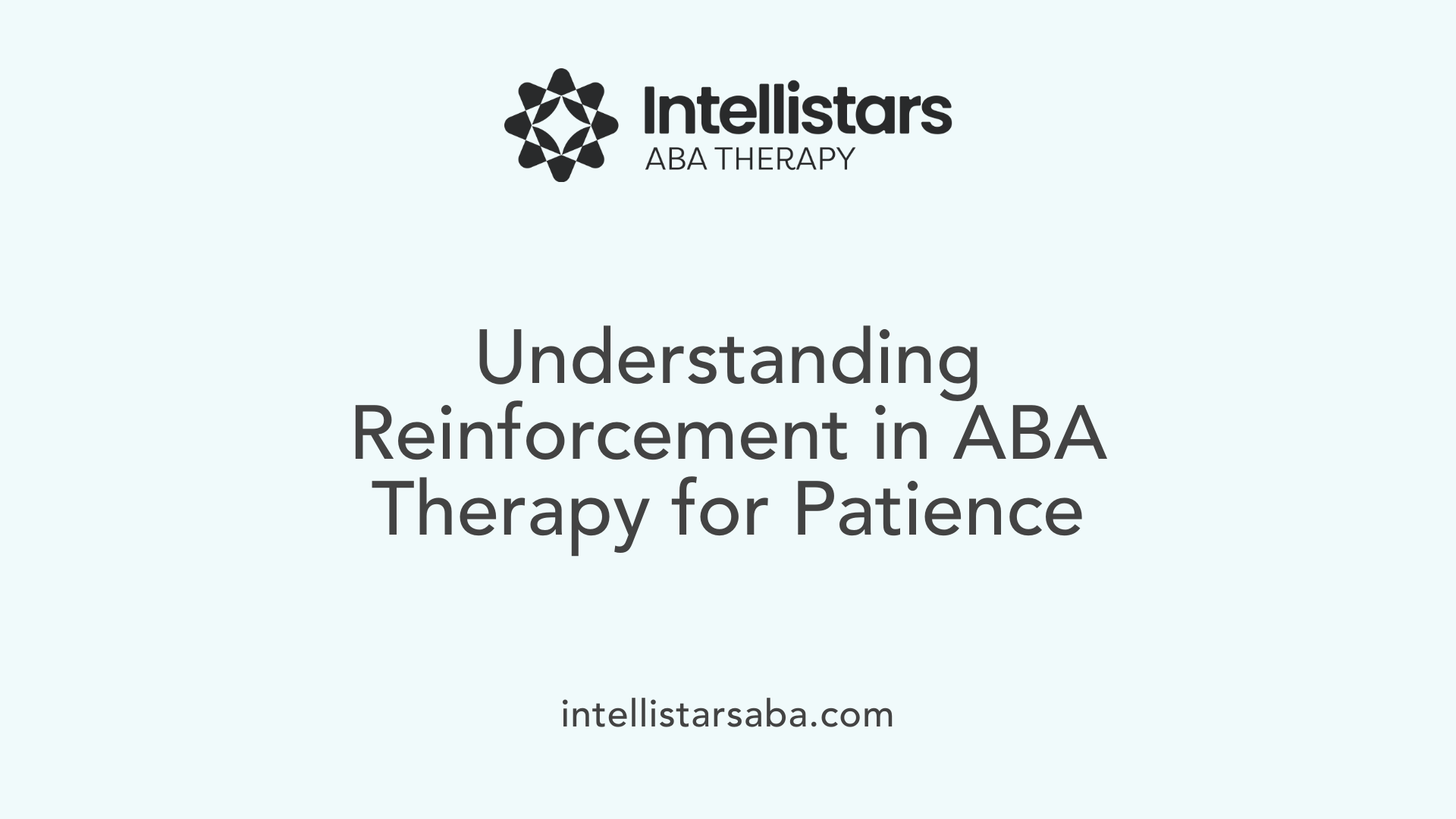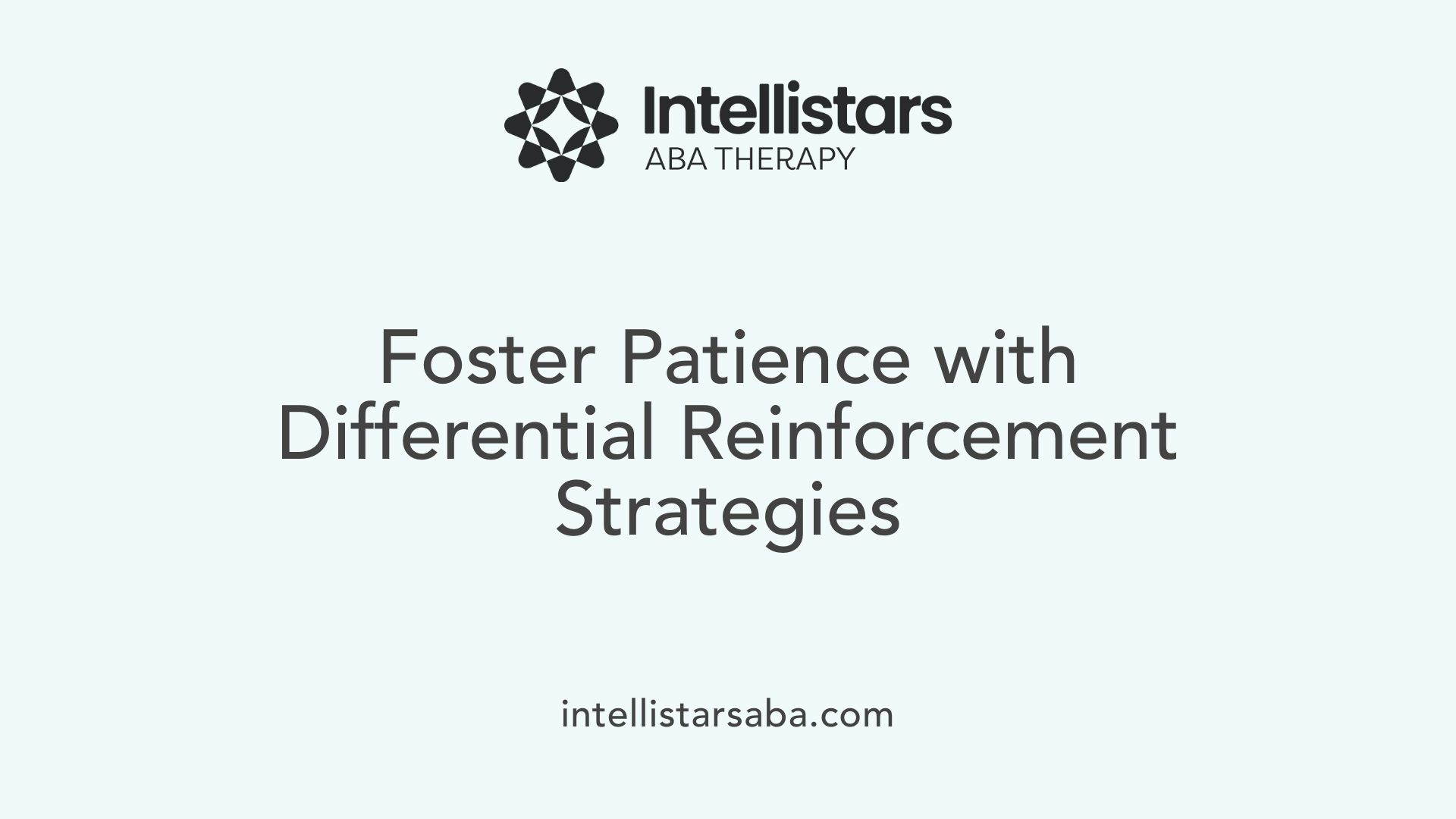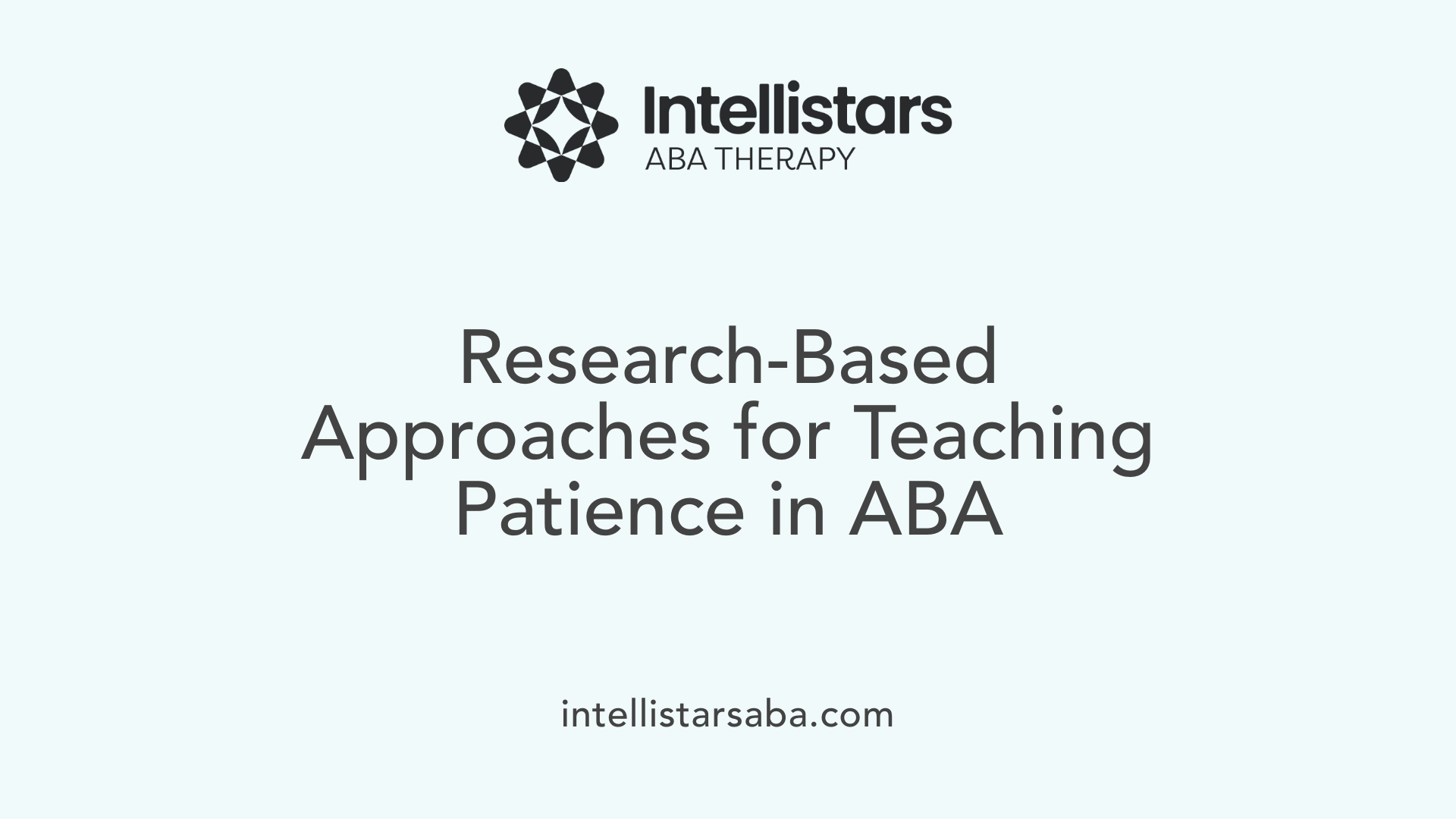Understanding the Role of ABA in Building Patience
Applied Behavior Analysis (ABA) is a scientifically grounded approach that effectively promotes patience and delayed gratification in children, especially those with autism spectrum disorder (ASD). By systematically applying reinforcement principles and utilizing specific techniques such as visual supports, reinforcement schedules, and differential reinforcement methods, ABA therapists can help children develop self-regulation skills essential for social and academic success.
Fundamentals of Reinforcement in ABA Therapy

How can ABA therapy be used to teach patience?
ABA therapy employs various strategies to help children learn to be more patient and control their impulses. One effective method involves using visual supports like timers, visual schedules, and wait cards. These tools help children understand how long they need to wait and what to expect during routines or transitions.
Reinforcement plays a crucial role in this process. When children demonstrate patience—such as waiting quietly or delaying gratification—they can earn praise, tokens, or access to preferred activities. These rewards increase the likelihood that the child will repeat the desired behavior.
Gradually, the duration of wait times is increased, allowing children to build their patience step by step. Distraction techniques, such as engaging toys or games, can also help children manage their impulses during waiting periods.
Modeling positive behaviors and using social stories reinforce the importance and expectations of patience in everyday situations. Consistent application of these strategies, and adjusting reinforcement schedules as the child's skills improve, helps foster self-regulation.
Through these evidence-based methods, ABA therapy guides children in developing patience, which in turn supports their overall impulse control and smooths transitions using manageable steps and positive reinforcement.
Teaching Delayed Reinforcement: Techniques and Strategies
What are effective ABA techniques and strategies for teaching delayed reinforcement?
In ABA therapy, helping children learn to wait for reinforcement is essential for behavior regulation. Several techniques and strategies are employed to teach delayed gratification effectively.
One of the primary methods is the use of token systems. These visual and tangible systems allow children to earn tokens for desired behaviors, which they can later exchange for bigger, preferred rewards. By gradually increasing the number of tokens required before access to the reward, children learn to wait patiently, reinforcing the concept of delayed gratification.
Visual schedules are also vital. These schedules clarify routines and upcoming reinforcement, helping children understand what to expect and reducing anxiety or impulsiveness. Clear visual cues serve as signals that reinforce is forthcoming, fostering patience.
Signaling potential reinforcement is another effective approach. Using verbal cues, visual timers, or auditory signals informs children that their chance for reinforcement is approaching. This communication cultivates a sense of anticipation and helps them tolerate delays.
Gradually fading the immediacy of rewards is crucial. Therapists and parents start by providing immediate positive reinforcement and slowly increase the wait time after each successful response. This progressive delay, known as fading, encourages the child to adapt to longer intervals without immediate reinforcement.
In addition to these strategies, the use of differential reinforcement, including DRA, DRI, and DRO, supports the development of patience. For example, reinforcing alternative appropriate behaviors such as asking for a break, instead of impulsively demanding immediate reward, helps children learn more acceptable ways to access reinforcement.
Another valuable technique involves functional communication training, which teaches children to communicate their needs effectively. When children can express themselves appropriately, they are less likely to act impulsively, making it easier to implement delays.
Overall, a combination of visual supports, token economies, signaling, and gradual shaping helps children build patience in ABA therapy. These methods develop their ability to wait, manage impulses, and respond adaptively, leading to more meaningful progress in social and behavioral skills.
Reinforcement Schedules and Their Impact on Patience Development

How does reinforcement scheduling promote patience in individuals receiving ABA therapy?
In ABA therapy, reinforcement schedules play a crucial role in teaching children to be patient and manage their impulses better. These schedules determine how and when rewards are given, shaping how long a child can wait for a positive outcome.
Interval schedules, such as fixed interval (FI) and variable interval (VI), encourage children to wait until a specific time passes or an unpredictable amount of time elapses before receiving reinforcement. For example, with fixed interval schedules, a child might learn to wait a set 15 seconds before getting a reward. This encourages patience as they become accustomed to waiting for the reinforcement.
Intermittent schedules, including variable ratio (VR) and variable interval (VI), promote sustained behavior without the expectation that reward comes every time. For instance, under a VR schedule, a child might receive a reward after an unpredictable number of responses—sometimes after three responses, sometimes after five—teaching persistence and patience through unpredictability.
Fading reinforcement delays is a technique where the wait times or response requirements gradually increase, helping children learn to tolerate longer periods of waiting. This progressive approach reinforces patience and delayed gratification.
Overall, carefully selecting and gradually adjusting reinforcement schedules helps children develop longer attention spans and tolerance for waiting. This strategic shaping makes them more patient and better equipped to handle situations that require impulse control in daily life.
Differential Reinforcement Methods to Cultivate Patience

What differential reinforcement methods are used to foster patience?
Fostering patience in children, especially those with ASD, often involves specific techniques rooted in differential reinforcement. These strategies include Reinforcement of Alternative Behaviors (DRA), Reinforcement of Incompatible Behaviors (DRI), and Reinforcement of Other Behaviors (DRO).
DRA involves rewarding behaviors that serve as acceptable alternatives to impulsive actions. For example, a child who waits calmly instead of interrupting or acting impulsively may receive praise or tokens. This helps the child associate patience with positive outcomes.
DRO is used by providing reinforcement when the child refrains from impulsive behaviors during a specified period. If the child manages to wait or stay calm without interruptions, they earn reinforcement. This increases the likelihood of waiting in future situations.
DRI promotes patience by reinforcing behaviors incompatible with impatience, such as deep breathing, sitting quietly, or self-soothing. These are behaviors that cannot occur simultaneously with impulsive or impatient actions.
By consistently applying these methods, children learn to understand that patience and self-control lead to positive reinforcement. Withholding reinforcement for impatient responses further accentuates this learning.
These strategies work best when implemented with regular data collection to track progress, reinforcement is chosen based on the child's preferences, and the reinforcement schedule is adjusted as the child improves. Overall, differential reinforcement methods play a crucial role in shaping patience while fostering self-regulation in children with ASD.
The Power of Visual Aids in Teaching Delayed Gratification

Token boards and their importance
Token boards are visual tools used in ABA therapy to promote positive behaviors, including patience and delayed gratification. They display a series of tokens or symbols that a child earns for exhibiting targeted behaviors. Once enough tokens are collected, the child can exchange them for a preferred reward. This system makes abstract ideas like rewards and progress concrete and visible, helping children understand the connection between their actions and outcomes.
Visual cues for patience
Visual cues, such as timers or picture cards, serve as prompts that guide children to wait patiently. These cues provide a clear expectation and signal when a reward will be accessible, reinforcing the value of self-control. For example, a visual timer can show how long a child needs to wait, reducing frustration and encouraging them to practice patience in daily routines.
Generalization of self-regulation skills
Using visual supports helps children apply self-regulation skills across different environments. When children learn to associate visual cues with waiting and effort in therapy sessions, they are more likely to transfer these skills to home, school, and community settings. Consistent use of visual aids fosters independence and enhances their capacity to manage impulses in various situations.
How do visual aids like token boards help teach delayed gratification?
Visual aids like token boards assist in teaching delayed gratification by offering a tangible and clear representation of progress toward a reward. Instead of relying solely on verbal instructions, children see their tokens accumulating, which helps them grasp the concept of delayed reinforcement. This visual contact with their progress reduces feelings of uncertainty and frustration.
The structured nature of token boards and visual cues clarifies routines and expectations, supporting children in understanding that patience and effort lead to positive outcomes. Over time, these visual tools foster emotional regulation, decrease problematic behaviors, and build the child's ability to tolerate waiting. Personalizing these supports ensures they are meaningful and effective, promoting independence and the generalization of self-regulation skills across different settings. Ultimately, consistent use of visual aids makes the process of learning delayed gratification more accessible and engaging for children with autism.
Research Evidence Supporting ABA for Teaching Patience
 Numerous scientific studies affirm the effectiveness of Applied Behavior Analysis (ABA) in teaching patience to children, especially those with autism spectrum disorder (ASD). Central to ABA are reinforcement strategies that encourage desired behaviors such as waiting and impulse control.
Numerous scientific studies affirm the effectiveness of Applied Behavior Analysis (ABA) in teaching patience to children, especially those with autism spectrum disorder (ASD). Central to ABA are reinforcement strategies that encourage desired behaviors such as waiting and impulse control.
Research indicates that positive reinforcement, including tokens, praise, and preferred activities, strengthens patience by rewarding incremental progress. For example, children are gradually exposed to longer waiting periods and reinforced for maintaining patience despite delays. These graduated approaches build self-regulation skills over time.
Structured training methods, like Behavioral Skills Training (BST), also play a significant role. BST involves careful instruction, modeling of patience behaviors, practice through role-playing, and constructive feedback. Such comprehensive training improves caregivers’ ability to teach children patience consistently across different settings.
Visual supports further support patience development. Tools like timers, wait cards, and visual schedules help children understand the concept of waiting and anticipate turns or delays. These supports are especially useful in autism interventions, where verbal instruction may be challenging.
Moreover, research emphasizes that consistency and reinforcement at home and other natural environments enable better generalization of patience skills. Collaborative efforts between therapists and parents ensure that children apply these skills beyond structured therapy sessions.
In summary, ABA’s combination of evidence-based reinforcement techniques, structured training, and visual supports creates a reliable framework for fostering patience in children with developmental challenges. This approach promotes self-control, reduces impulsiveness, and contributes to improved social functioning.
Managing Impulsivity and Promoting Self-Regulation
How can ABA principles be applied to manage behaviors related to impatience?
Applied Behavior Analysis (ABA) offers practical strategies to address impulsivity and develop self-control skills. The approach begins with a thorough assessment, typically through Functional Behavior Assessments (FBA), to understand what triggers impatience or impulsive behaviors.
Once causes are identified, ABA therapists use positive reinforcement to encourage patience. For example, children might earn tokens or praise each time they wait patiently or demonstrate self-control. These rewards can motivate children to practice patience consistently.
In addition to reinforcement, naturalistic teaching methods can help children apply patience in real-life situations. During everyday activities, adults can create opportunities for children to practice waiting, such as waiting for their turn or delaying gratification.
Visual supports like timers or social stories are also effective. Timers help set clear expectations about how long to wait, reducing frustration. Social stories can teach children about patience in understandable ways.
Teaching coping skills and calming techniques is another part of the process. Techniques like deep breathing, counting, or using sensory objects can help children manage their impulses proactively.
By combining these methods—behavioral strategies, visual supports, and emotional regulation skills—ABA helps children develop greater self-control and decreases impulsiveness over time.
Practical Implementation: Teaching Impulse Control and Delayed Rewards
In ABA therapy, helping children improve their impulse control and learn to wait for rewards involves a combination of structured techniques and supportive environments. Establishing routines and clear expectations provides children with predictable structures, which can reduce impulsive behaviors by making behavior expectations explicit. Regular routines at home or in therapy settings help children understand what is expected, decreasing the likelihood of impulsivity.
Using role-play and social stories offers safe spaces for children to practice appropriate responses to various situations. These methods allow children to see and rehearse behaviors, such as waiting patiently or managing frustration, within controlled scenarios, building their decision-making skills.
Teaching deferred gratification is essential for impulse control. This can be achieved with token systems, where children earn tokens for desired behaviors and exchange them after a delay, or through reinforcement schedules that involve waiting periods before receiving rewards. Gradually increasing the delay helps children develop patience, recognize the value of waiting, and improve their ability to manage impulses.
Furthermore, reinforcing emotional regulation strategies, such as deep breathing or counting, supports self-control during challenging moments. Visual aids like schedules or antecedent logs can remind children of behavioral rules and consequences, especially during calm moments, to reinforce understanding.
Overall, applying these ABA techniques in everyday routines, activities, and therapy sessions creates a consistent approach that fosters impulse control. The focus on teaching patience, setting clear expectations, and reinforcing delayed rewards equips children with essential self-regulation skills that benefit their social and emotional development.
Supporting Long-Term Success with ABA Techniques
Incorporating a comprehensive array of ABA strategies—including visual supports, reinforcement scheduling, differential reinforcement, and naturalistic teaching—empowers children to develop the patience and self-control necessary for navigating social and academic environments. Active engagement of parents, caregivers, and educators, along with consistent application of these evidence-based approaches, not only promotes immediate skill acquisition but also ensures lasting behavioral change. Ultimately, effective use of ABA can transform impulsive behaviors into adaptive responses, laying the foundation for lifelong self-regulation and success.
References
- What is the Role of Reinforcement in Impulse Control - Childwise ABA
- How To Navigate Success and Setbacks in ABA Therapy
- Behavior Management in ABA Therapy: A Guide for Parents
- teaching a child with autism spectrum disorders to tolerate delayed ...
- How to Use Positive Reinforcement in ABA Therapy Effectively
- What is Differential Reinforcement? Exploring its Applications
- How to Implement & Use Token Boards - How to ABA






